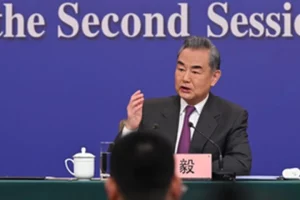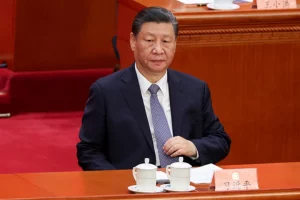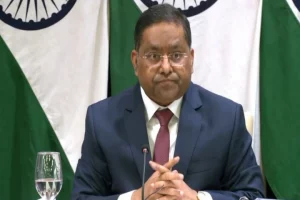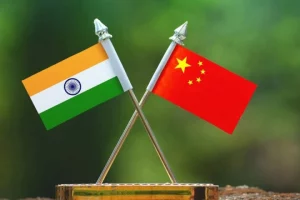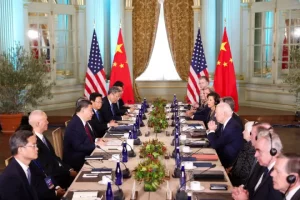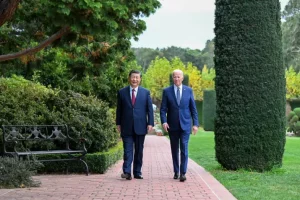Hopes of an India-China thaw, which can happen following military disengagement along remaining friction points in eastern Ladakh are alive after Prime Minister Narendra Modi and Chinese President Xi Jinping met in Johannesburg on the sidelines of the 15th BRICS summit.
Foreign Secretary Vinay Kwatra confirmed that the two leaders had met during the course of the summit.
Prime Minister Modi seen chatting with President Xi as the BRICS leaders make their way to the stage for the press briefing in Johannesburg on the final day of the Summit.
Video courtesy: SABC pic.twitter.com/qQUbfGyoHY
— Dhairya Maheshwari (@dhairyam14) August 24, 2023
Briefing the media Kwatra said that during their conversation, PM Modi highlighted India’s concerns on the unresolved issues along the Line of Actual Control (LAC) in the western sector of the India-China border.
He added that the Prime Minister underlined that the maintenance of Peace and tranquillity in the border areas and observing and respecting the LAC are essential for the normalisation of the India-China relations.
“In this regard the two leaders agreed to direct their relevant officials to intensifying efforts at expeditions disengagement and de-escalation”.
#WATCH | Prime Minister @narendramodi held a conversation with Chinese President Xi Jinping on the margins of #BRICS Summit. PM Modi highlighted India’s concerns over the situation at the LAC to Xi Jinping: Foreign Secretary Vinay Kwatra@PMOIndia @MEAIndia #BRICSSummit2023 pic.twitter.com/Z3RsR9ioeI
— DD News (@DDNewslive) August 24, 2023
Though further details about the conversation are still not available, at least two takeaways can be immediately discerned.
First, a political direction has been imparted to urgently defuse military tensions by addressing “unresolved issues” in eastern Ladakh.
Following corps commander level talks that began in 2020, the two sides have disengaged from five friction points — Galwan, the north and south banks of the Pangong lake, at Patrolling Point (PP) 17 in the Gogra-Hot Springs area and PP 15.
However, deal-breaking differences remain in the Depsang Plains and Demchok. India has maintained that there are two more friction points there. China rejects the Indian position pointing out that these are legacy issues predating 2020 when the India-China standoff began in April of that year.
Ahead of the Johannesburg summit, the corps commanders of the two countries held marathon talks, followed by a Major General level dialogue presumably to iron out differences in the Depsang Plains and Demchok.
After today’s talks at the highest level, official level talks are expected to intensify to achieve a breakthrough. Though no timelines are stated, a modus vivendi cannot be ruled out before the two leaders meet again in New Delhi for the G-20 summit early next month.
Second, the Prime Minster has made it plain that the tensions at the borders cannot be de-coupled from economic and other forms of engagements when he said that Peace and Tranquillity in the border areas and observing and respecting the LAC “are essential for the normalisation of the India-China relationship”.
The intensity of the military dialogue that began ahead of the BRICS summit followed two key meetings between Wang Yi, the head of the foreign affairs commission office of the Communist Party of China (CPC), now also the foreign minister, with National Security Advisor Ajit Doval and External Affairs Minister S. Jaishankar earlier.
The political direction imparted in Johannesburg reveals the underlying currents that are confronting China. For instance, China’s geo-economic realignment with India is now important, as Beijing’s export-led growth model has taken a big hit. In the post-Covid era when western economies have weakened, the demand for Chinese products has dropped significantly in North America and Europe.
Besides, with mantra of de-risking echoing powerfully in western capitals, the movement of foreign capital into China has also entered a zone of uncertainty. In fact, capital outflow from China to other geographies including India, tagged with alternate supply chains, is on the radar.
For a country that is a master of cold calculations, it may not be a surprise that the CPC has decided to foster a big economic engagement with India. But this cannot happen unless there is a thaw at the borders in Ladakh, given India’s hyphenation mantra of not decoupling the border and economy.
Besides, there is big geopolitical dimension centred around Taiwan. The Chinese can no longer afford to ignore the cementing of ties between India and the United States, visible in plain sight during Prime Minister Modi’s high-octane visit to Washington, followed up by exceptionally high-profile outing to France. China can simply not afford Indo-US ties to gather further momentum, especially in view of the situation in Taiwan.
Also Read: Why stars maybe aligning for a Modi-Xi meeting during BRICS at Johannesburg







